

Over five days in June a party of 38 Hardy Planters visited nine special gardens in East Anglia to celebrate the 50th anniversary of the Hardy Plant Society. Our thanks to David and Pippa for organising such a splendid tour, with everything running so smoothly for the rest of us. Here are some of the recorded memories, and some photos. But first some thoughts from a member of the Herefordshire and Mid Wales Group.
“In January our Group Secretary reported that she had received a letter from David Pollitt of the Worcestershire HPS Group asking if any of our members would be interested in a trip to see gardens in East Anglia in June. As Glen Chantry, East Ruston Old Vicarage and Hyde Hall had long been on my list of "Gardens to Visit" and the dates were pretty clear in the diary I emailed Uta in New Zealand to see if she would be interested in coming too. I had no idea at that time what a marvellous trip it would turn out to be.
“I think my favourite gardens were the Old Rectory at Sudborough and Coton Manor followed by Beth Chatto (had been there before) and Sundown. East Ruston Old Vicarage was amazing (don't know how else to describe that one). Shall definitely be taking my husband to see the Northamptonshire two. It was a very pleasant hotel as our base, and you even organised the weather too. Shall remember all those plants at coach packing time on the last morning and wondering whether Pep was going to be packed into the hold with the cases.
“So thank you Worcestershire Group for including us "interlopers", for all your friendship and fun, and especially to Pippa and David for organising one of the best holidays which went so smoothly (was there a tiny hiccup at Glen Chantry?). Please put us on your mailing list for future holidays.”
The first stop on our tour was at one of the country's grandest houses and estates where everything was on a suitably grand scale. The focus of our attention was the five-acre walled garden that adjoined the stately pile built by Prime Minister Sir Robert Walpole outside Kings Lynn in the 1720's. The garden had been fully restored within the last fifteen years and, following the current trend, divided into a series of 'rooms'.
Given the scale of the site, the word 'room' hardly seems adequate to describe the size of some of the rectilinear enclosures. One, for example, was a full-sized croquet lawn, complete with equipment and an invitation for visitors to enjoy a game. Another featured a stunning 120 yard long double herbaceous border, mirror planted, and edged with frothy blue nepeta alive with bees. At the end stood a striking rustic gazebo decorated with antlers from the famous herd of white deer we were later to sight in the park. The planting in the borders, as throughout, was designed with an eye to structure, obelisks adding height to the natural stature of plants such as eremurus and cardiocrinum.
Other borders were themed, although inevitably not all were at their best. The irises, for example, were long over in the cherry walk as was the wisteria covering the pergola. A further border was dedicated to peonies that were past their prime and had suffered badly in the torrential rain of the previous weeks as had all the roses. The inter-planted lilies had yet to flower.
The centerpiece of the garden was the rose garden. This was enclosed by tall yew hedges lined with borders planted with older rose varieties interspersed with foxgloves and delphiniums. A lower undulating series of yew hedges framed the inner rose garden in which blocks of bush roses were contained within a box-edged parterre. The focal part of this formal garden was a sunken water feature with a fine display of arum lilies and a restful seating area. Huge stone statues of classical figures were a reminder of the grandeur of the house and estate to which the garden belongs.
Before departing, some of the Group managed to fit in a visit to the house itself while the Marquess of Cholmondeley's amazing collection of model soldiers in the old stable was a surprise bonus.
Eighty years ago The Garden in an Orchard was a newly-planted orchard. Since 1964 Mr and Mrs Boardman have progressively cleared trees they didn't want, first to run an alpine nursery, and since 1972 to begin the garden, which is now 3.5 acres.
Mr Boardman 'really knows about' trees and shrubs; Mrs Boardman does the 'underplanting'. The trees provide shelter, focal points and a background - they include several eucalyptus, left to grow to their full size and wonderful to see. Mrs Boardman, whose group I was in, pointed out catalpa, Eleagnus 'Quicksilver' and Metasequoia glyphostrobodies. Some old fruit trees are the centres of what might be called 'island beds' and others form an espalier avenue, half fruit tree and half willow.
The herbaceous plants are used as a palette - appropriate that Persicaria "Painter's Palette" is in the garden - of mostly subtle colours. There are no harsh yellows or oranges, but the soft yellows such as phormium accent the mostly mauves and pinks of this time of year, and a kiwi tree gives soft orange. 'Opium' poppies add rich colours; and Cornus kousa's spectacular cream bracts, beginning to turn a little pink, brought gasps from us all.
The visit to the Boardmans' garden came between Houghton Hall and East Ruston - both more spectacular and grander. But I found The Garden in an Orchard inspirational in its use of planting and less obvious colour: for me, informal English gardens don't get any better than this.
This was the largest garden visited on the trip at 32 acres & on the wettest afternoon. It was purchased in 1973 by Alan Gray and Graham Robeson it is maintained by them with the help of 3 full-time and 3 part-time gardeners. The whole area has been planned & planted as a series of 'rooms', vistas & long walks, the object being to accommodate modern farming methods - 24 fields have been incorporated into a single field. Due to its position 1.5 miles from the east coast there is very little frost & this has enabled many exotic & tender plants to be grown.
Even after being made aware of the above,
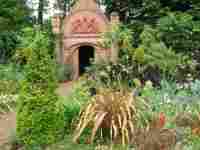
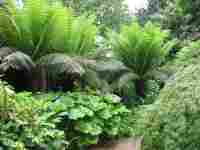
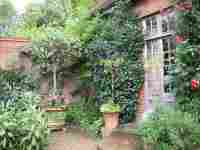
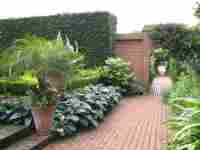
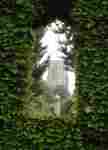
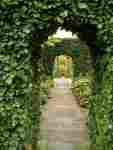
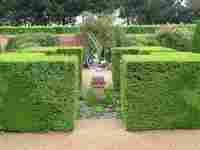
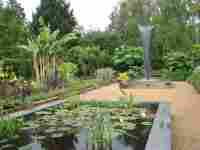
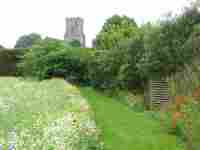
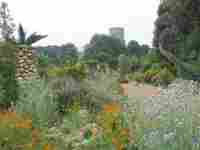 it was still surprising to enter the first walled garden & find it bedded out with numerous Aeonium arboreum 'Zwartkop' & many other tender exotics. This was to be the first of many jaw-dropping experiences - every new area entered had the WOW factor in abundance. Behind the house the garden opened out into the Dutch Garden containing wonderful topiary, pots & beds full of colour with long views down immaculate lawns & hedges.
it was still surprising to enter the first walled garden & find it bedded out with numerous Aeonium arboreum 'Zwartkop' & many other tender exotics. This was to be the first of many jaw-dropping experiences - every new area entered had the WOW factor in abundance. Behind the house the garden opened out into the Dutch Garden containing wonderful topiary, pots & beds full of colour with long views down immaculate lawns & hedges.
There were bananas, palms & tree ferns all with luxurious under planting giving a green 'jungle' feel. The exotic garden itself included two lovely raised ponds edged in dressed lead, one having a tall fountain designed to resemble a twister. This area could be viewed from above through a pergola which was accessed from the tranquil sunken garden. The latter included another pond at the centre of which was a stainless steel & blue glass sculpture and seemed rather incongruous.
Clipped yews, topiary & hedges were features in many of the different spaces - Leila especially liked the curved beech hedges. Not all the gardens were formal; there was a cornfield full of wild flowers, a Californian border & Desert Wash with cacti, agaves & eschscholizias which would have glowed in the sunshine. The Mediterranean garden consisted of a series of south facing walled terraces which helped retain heat & enhanced the exuberant planting. Here there were tall Echium pininana & groups of a beautiful deep apricot kniphofia for which Wendy would have liked to have found the name.
A well laid out vegetable & cutting garden provided the owners with produce & an apple walk had a view of Happisburgh Church between two poplar trees. Happisburgh Lighthouse was also visible from the Winter Garden through a porthole cut in the pine shelterbelt.
Despite the time and effort that had obviously gone into creating this unique garden, on reflection, we both felt that every one of the 20+ individual gardens could be classed as a 'show' garden in its own right & so many gardens were difficult to take in all at once without experiencing sensory overload.
However, it WAS well worth visiting East Ruston - pure theatre in the Norfolk countryside.
This was the third of our East Anglian gardens to visit on our '07 tour' - and it certainly was an eye-opener!. This private garden - a huge area of thirty-two acres is meant to be shared and enjoyed. It is certainly a surprising place!
Lying a mile and half from the North Sea, it offers the visitor a kaleidoscopic experience of garden design and colourful landscaping which incorporates the local lighthouse as a coastal vista and the churches of St Mary's and Happisburgh with their rural aspect seen through the 'windows' in the foliage of trees.
The house and gardens, owned by Alan Gray and Graham Robeson, was bought in 1973 and developed in 1989, after retiring from their jobs in London. Nearby fields have been purchased and hard work since then has been rewarded. Whilst developing the arable and prairie fields they have given thought to replacing the habitat for birds and animals and encouraged a renaissance of hedgerow culture for today's wildlife.
Entering the garden, pathways led us from succulents to dry prairie and through a blue gate into an area with palm trees and ferns providing a jungle atmosphere. We followed a map which was a great help, considering the extent of the area we were encouraged to discover, and we passed by an ornamental greenhouse in which tender plants gently entwined and we could see the Dutch garden beyond, where planting is changed twice a year. It had box obelisks and balls and clipped ilex balls in a frame and placed around within a large border. Passing under a large birch archway, our curiosity led us to a lawned garden, with ten yew obelisks and from the house there was a series of steps of different levels leading to a pavilion, and a box parterre, at the far end. This is the Kings Walk.
The red and purple border had a delightful wooden summerhouse, where we sat a-while, looking back across the formal Dutch gardens sitting amongst a garden of perennials and exotics. From here and through an archway in a beech hedge we passed into a holistic garden, which was calming to the senses and as a contrast through the next archway was another garden, with ten large tree ferns - their fronds almost touching - resembled mediaeval vaulting as you passed beneath. For all its initial element of surprise it seemed a very peaceful place, indeed an oasis.
Another archway led to a sunken garden, with its raised beds and special plants - the design encouraged planting on two levels. Passing through we went under a vine clad pergola to enter the exotic garden with its banana trees. Two raised beds complementary in design - one held fish and raised planting, the other with an amazing fountain which spouted water in onto itself (to avoid splashing), a design by Giles Rayner to resemble a 'twister water spout' - occasionally seen off the North Sea coast.
The West Field and Woodland garden with its acers, viburnums and a collection of hydrangeas for their early autumn colour followed. To the East was Holly Field Garden and north was the New Zealand garden, with rare plants growing between phormiums and cordylines. Blue ceanothus and golden hues of marigolds welcomed us into the Californian border protected by trees including eucalyptus. The Mediterranean Garden (below a desert wash) was South Facing and reminiscent of the Canaries and Mexico, bright colourful flowers looked good against a brick-red summerhouse. Near to this was a wonderful vista, seen from the apple walk with its espaliers, of St Mary's Church. This was followed by entering the Winter garden, with its dogwoods, eucalyptus and hollies - also seen through a port-hole cut into a Monterey pine was a long vista towards Happisburgh Lighthouse - which looked spectacular through a sea mist.
Finally we saw the East Field with its wildlife pond and group of trees already under-planted - aiming to be a woodland garden eventually. Also a Vegetable Garden - planted up in rows for easy hoeing and a cutting garden for house plants.
Everybody ended up in the tearoom, with not only its topiary squirrels and teddy bears to welcome us, but also cabinets full of an astonishing array of wonderful home-made cakes - just the place to sit together and exchange our views on the experience of these gardens of abundance. Comments were 'wonderful to see' ... 'worth visiting' ... 'flamboyant' .. 'world of ideas' ... 'utter theatre' ... 'prefer something simpler' ... 'over the top' ...'like Hidcote'... For me, I felt all the hard work and digging had found buried treasure - seeds of ideas which had sprung into life to create this oasis of pleasure, so unexpected on the North Sea Coast. Such a 'grand tour' of the world created within 32 acres of prairie and arable land. At the entrance as we had gone in initially was a terracotta coat of arms at the Postman's Gate - it was inscribed by the motto 'Consilia et labore' - (by council & labour) - what a find for two people who have worked so hard on their dream!
Tuesday saw us visiting two more very different gardens in warm sunny weather. The first, Sundown at Roydon near Diss is a 1 acre private garden owned by Liz Bloom which extends to the side and back of her house. It is fronted by a hedge of Prunus cerasifera nigra with an area of woodland to the side including specimens of Contorted Hazel (Corylus avellana contorta), Dawn Redwood (Metasequoia glyptostroboides) and Paper Bark Maple (Acer Griseum). We were too late for the rhododendrons but interest was maintained by growing clematis and other plants through them. The borders at the rear of the garden containing many herbaceous plants and shrubs were immaculate and, as I sat drinking my coffee in the sun, I appreciated the careful planning with gradations of colour and form, shading from pinks to mauves to blues. A new vegetable area is being planned on the other side of the house and I am sure that this will be as beautifully maintained as the rest of the garden. This was a garden that I felt could be managed by any keen gardener.
Then it was off to The Beth Chatto Garden at Elmstead Market near Colchester, a garden on a different scale altogether. We started with the famous Gravel Garden, looking good although it has never been artificially watered or fertilised although the soil was carefully prepared at the start. Bergenias were much in evidence as was a large specimen of the Mount Etna Broom, just starting to flower. As to be expected there were many lavenders, cistus and other silvery leaved plants. We experienced a complete change as we moved on to the Water Gardens where gunneras, phormiums and astilbes flourish followed by the Woodland Garden where we saw candelabra primulas, epimediums and heucheras amongst others. I would love to see this
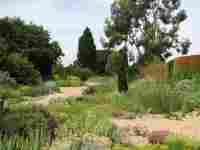
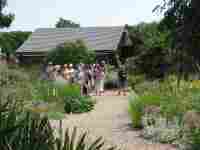
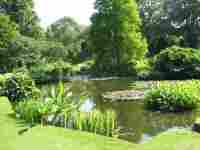
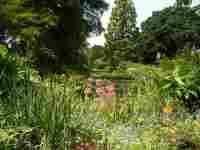
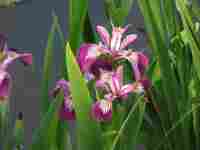
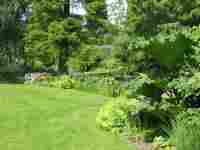
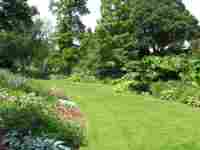
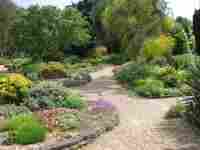 in the spring when snowdrops and other early plants are in flower. The last garden is the newest - the scree beds with alpines and a large Cercis Siliquastrum (Judas Tree) as the focal point. Some of us were lucky enough to see Mrs Chatto sitting in her private garden savouring a cup of tea. After that it was on to the excellent nursery where once again we stocked up with plants, no doubt to the despair of Pep our friendly coach driver, and then back for dinner in Ipswich.
in the spring when snowdrops and other early plants are in flower. The last garden is the newest - the scree beds with alpines and a large Cercis Siliquastrum (Judas Tree) as the focal point. Some of us were lucky enough to see Mrs Chatto sitting in her private garden savouring a cup of tea. After that it was on to the excellent nursery where once again we stocked up with plants, no doubt to the despair of Pep our friendly coach driver, and then back for dinner in Ipswich.
The introduction to the famous Beth Chatto garden was courtesy of an enthusiastic and 'snippetful' Debbie. Her 20 years of experience in the nursery and gardens made the wander around the gardens most entertaining. However one of the highlights was the plantaholics let loose into the abundantly stocked nursery beds and one of us - his name will not be mentioned (providing I can have some seed!), acquired a rather unusual veratrum nigra after charming another member of staff to forage in a particularly precious stock bed - another illustration of the friendliness and homely feel to the whole set up.
This is a garden which supremely illustrates companion planting at its most creative and most environmentally friendly. With healthy, happy plants placed in carefully researched and prepared conditions they dare not fail. The overall feel was charming, and the grouping of leaf form and shape was truly sensational.
Most memorable for me was the gravel garden sculpted out of a compacted car park. Having recently devoured "Dear Friend and Gardener" I knew that what appeared to be a seamless natural planting in lush swathes had caused Mr and Mrs Chatto many traumas and moments of hosepipe temptation. I loved it even more as a result.
Aside from the wonders of the lush damp garden and tempting stock beds was the look of panic on our driver's face when around the neatly trimmed hedges appeared the crocodile of happy hardy planters with their purchases - his first real experience of Hardy Plant Hunters!
A quick flip down the A12 from our excellent hotel in Ipswich brought us to within striking distance of the site of the Battle of Maldon in 991. All was peace and quiet however, as we arrived at the main gate to Glen Chantry with its unambiguous sign. It said CLOSED. This HPS party was made of stern stuff so, undaunted we walked on through the gate and up the drive to a fine large modem house and David Pollitt set off in search of human life. A few moments later he returned with Wol Staines, the owner, (with his wife, Sue) who was spitting a few nails over our failure to get the coach to where he had been awaiting us.
That over, we gathered at the edge of a large rockery for Wol's introduction. Wol and Sue, both former teachers, had started their 3 acre garden in 1977 on a gently sloping and SW facing site. The Rock Garden leads to the main glory of Glen Chantry which is a number of large curvilinear beds, some raised, where trees form the backdrops and focal points to floral layouts, with an acknowledged nod to Beth Chatto's work.
The overall effect, which is clearly intentionally enhanced by the slope of the site, is the creation of near innumerable vistas, which produce a kaleidoscopic impression at strolling speed of magnificent colour, shape and form. The trees had not been planted in excess but in the breeze on a sunny morning, the dappling of sunlight and the very great range of floral colour that had been employed, produced an effect almost mesmeric. The perfectly tailored lawns, with edging you could have cut your finger on, simply pointed up the beauty of the flowerbeds.
If I had been handed ownership of Glen Chantry that morning, I should have sat around enjoying it, totally failing to give it the huge amount of attention its presentation constantly demands.
"Ah!" Wol had said as we left Glen Chantry, "You are leaving our amateur garden for Institutional Gardens. Gardens in transition", he added darkly. The first thing you see about the RHS Garden (it likes to be so named in the singular) is that it is on the top of a hill. In Essex! And other hills are clearly visible! What kinder punishment than to bring those who maintain that the county is flat, to this wonderful spot to see the error of their ways. Of course Wol was right on both points: these are what you would expect of an RHS Garden. Peculiarly English formality, order, restraint, variety, buffeted about by maritime weather and still looking marvellous. But one's eye keeps being distracted by the views of un-flat Essex all around.
And there's active change here, with work well advanced on what will be soon be an exciting looking reconstructed "Robinson's Garden", a near circular sunken garden with its stone retaining walls and surrounding paths and beautiful oak footbridges already in place.
The only jarring note was the Dry Garden. With the memory of the glories of Glen Chantry only hours old, it seemed to be offering me a view into the near future, where global warming had become unstoppable, which I didn't much care for!